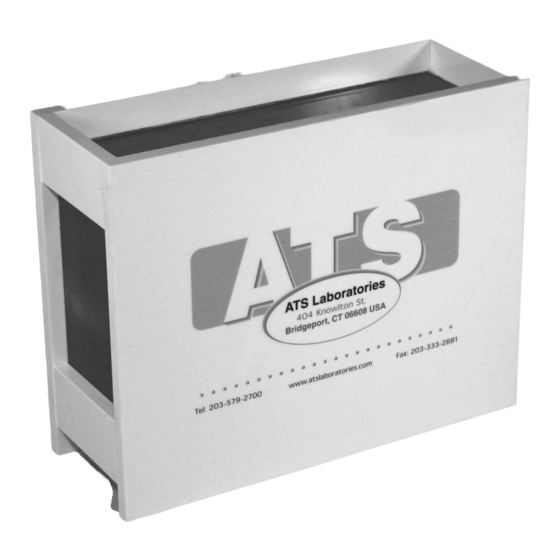ATS 570 Gebruiksaanwijzing - Pagina 7
Blader online of download pdf Gebruiksaanwijzing voor {categorie_naam} ATS 570. ATS 570 13 pagina's. Multipurpose - endoscopic phantom

1. Scan the phantom until the dead zone target group is clearly displayed. Freeze this image.
2. This group is composed of 9 line targets. The first target is positioned 2 mm below the scan surface.
Subsequent targets are spaced 1 mm apart, to a depth of 10 mm.
3. Using the electronic calipers, measure the distance between the first target imaged and the echo produced by
the scan surface. The resulting value will be the depth of the dead zone.
4. Document the depth measurement on the quality assurance record.
Results
The system's dead zone should remain consistent from week to week when using the same instrument settings
and Model 570 phantom. Compare the test results obtained from the baseline records. If the current image
demonstrates changes in the system's ability to resolve these targets, corrective action should be considered.
VERTICAL MEASUREMENT CALIBRATION (B1 & B2)
Description and Reason For Testing
Vertical distance measurements are obtained along the axis of the sound beam. Accurate representation of the
size, depth and volume of a structure is a critical factor in a proper diagnosis. Most imaging systems use depth
markers and/or electronic calipers to obtain these measurements. The phantom is scanned and a distance
measurement obtained using the timing markers and/or electronic calipers. The resulting measurement is then
compared to the known distance between the line targets in the phantom. The accuracy of vertical distance
measurements depends on the integrity of the timing circuitry of the imaging system.
Testing Procedure
1. Position the transducer over the vertical group of line targets until a clear image is obtained. Freeze the
display.
2. Using the electronic calipers or the timing markers measure the greatest distance that can be clearly imaged
between line targets.
3. Document the measurement obtained on the quality assurance record.
Results
The system's vertical distances measurements should remain consistent from week to week when using the same
instrument settings and Model 570 phantom. Compare the test results obtained from the baseline records. If the
current image demonstrates changes in the system's ability to resolve these targets, corrective action should be
considered.
HORIZONTAL MEASUREMENT CALIBRATION
Linear Horizontal Group (C1 & C2)
Sector Horizontal Group (D1 & D2)
Description and Reason For Testing
Horizontal distance measurements are obtained perpendicular to the axis of the sound beam. Proper diagnosis
depends on the accurate representation of the size and volume of a structure being examined. Most imaging
systems use distance markers and/or electronic calipers to obtain these measurements. The phantom is scanned
and a distance measurement obtained. The resulting measurement is then compared to the known distance in the
phantom. The accuracy of the horizontal distance measurements depends on the integrity of the transducer
scanning assembly, the output intensity and the resolution of the imaging system.
Testing Procedure
Note: The Model 570 General & Small Parts phantom provides two scanning surfaces used to evaluate horizontal
measurement calibration. Due to the geometry and variety of sector scan transducers a separate set of horizontal
line targets are provided to evaluate lateral resolution. Please refer to the specification page for the location of
these groups.
7
